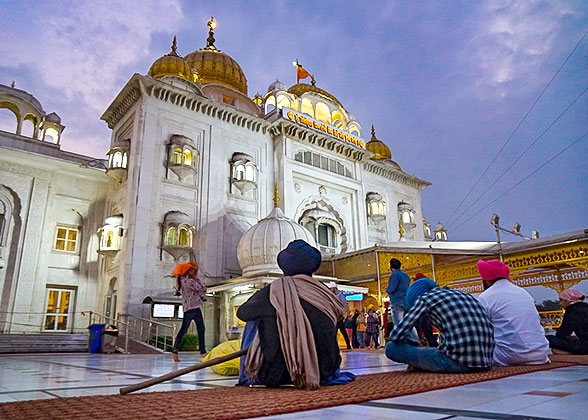- Taj Mahal
- Agra Fort
- Fatehpur Sikri
- Mehtab Bagh
- Tomb of I'timād-Ud-Daulah
- Akbar’s Tomb
- Jama Masjid
- Buland Darwaza
- Yamuna River
- Wildlife SOS
Tomb of I'timād-Ud-Daulah (Baby Taj), Agra
The tomb of I'timād-Ud-Daulah is one of the hidden architectural masterpieces in Agra which is the center of Mughal reign with enormous Mughal structures, forts and palaces. Popularly known as the ‘mini version of Taj Mahal’, the tomb of I'timād-Ud-Daulah is a mausoleum of a Persian merchant, who was a significant part of the Mughal’s court.
Historic Background of the Tomb
Mirza Ghiyas Beg worked as a treasurer during Akbar’s reign and was raised to the post of Wazir by Jahangir. Also, Jahangir, while conferring respect to his father-in-law for his immense dedication and contributions, gave him the honorary title - ‘I'timād-Ud-Daulah’ which means ‘the Pillar of the State’. Post the burial of Mirza Ghiyas Beg, the mother of Noor Jahan, Asmat Begum was also buried here. The exquisite tomb of I'timād-Ud-Daulah was constructed in a span of six years from 1622 to 1628, with intricate craftsmanship of the artisans. Constructed on the orders of Noor Jahan, the wife of the then Mughal emperor, Jahangir. The mausoleum was being built by her in the loving memory of her father, Mirza Ghiyas Beg, who was the Chief Minister in Jahangir's court. Nur Jahan represents one of those Mughal women, who were self-financing the designing of the tomb and various other monuments.
Quick Glance
![]() Location: Moti Bagh, Agra, Uttar Pradesh
Location: Moti Bagh, Agra, Uttar Pradesh
![]() Timings: 8:00 am to 12:00 am
Timings: 8:00 am to 12:00 am
![]() Entry Ticket Fare: INS 310. Children below 15 years have free entry.
Entry Ticket Fare: INS 310. Children below 15 years have free entry.
![]() Best Time to Visit:
Best Time to Visit:
As the mausoleum is accessible from morning to night. One can visit anytime. However, the ideal time to visit the tomb is morning, which enhances the grand appearance further.
![]() How to Reach:
How to Reach:
Nearest Airport: Pandit Deen Dayal Upadhyaya Airport
Nearest Bus stop: Inter-State Bus Terminus, Agra
Nearest Railway station: Agra Fort Station
Nearby Places to go: Agra Fort (4km), Chini Ka Rauza (1.5km)

|
Architecture
The tomb is constructed in a garden with four gateways at the eastern coast of the Yamuna River. Taj Mahal is exactly on the opposite side of the tomb but it can hardly be seen from here. Enclosing the tomb structure is lavish greenery which makes it seem like a precious gem amidst the greenery. The four gates resemble the pattern of symmetry which is invoked in most of the Mughal structures. The two entrances are for maintaining the symmetry, from the other two, one connects to the Yamuna River and the last one is the entry gate which gives entry allowance to the tourists.The mausoleum is built on the red sandstone within the garden premises which belong to Itimad - Ud Daulah himself. The entire structural fabrication of the mausoleum is done by marble, unlike sandstone which is used in most Mughal monuments. Therefore, the tomb has relevance in Indian architectural history, being the first monument to be built entirely with marble in the country.
The tectonic details of the mausoleum include a chief domain encompassed by four minarets attached to it from the base. The large garden around this exotic masterpiece consists of water channels and criss-cross walking lanes. The four minarets encompassing the central dome have a semi-umbrella based kiosk arches. The luscious garden signifies the regular construction trend of the Mughals with the desire to bring peace, serenity and rejuvenation. There are enormous carvings and inscriptions which are flower patterns, geometric or dynamic traces. The structure of the tomb, like every Mughal structure, is aligned in the direction of the Islamic Holy City, Mecca.
|
|
|
The salient characteristics of the mausoleum are the extensive veils of marble and the art-pieces curated from pietra-dura. The intrinsic fashion of the monument is a bit effeminate, unlike the other conventional Mughal structures which possess a lot of virile, gallant and manly style.
Other Attraction Nearby Recommended
There are a lot of architectural similarities between the Taj Mahal and the tomb of I'timād-Ud-Daulah. Like, the fundamental structure with four minarets is similar. Though, there is a difference in the shape of the domes. Also, the smaller structural aspects reflect the wazir position of Mirza Ghiyas Beg. This refers to the term - “Baccha Taj”, “Chota Taj” or “Baby Taj”. However, the monument is the hidden and mysterious place it has very few visitors as compared to Taj Mahal.The tomb of Mirza Ghiyas Beg is also considered as the ‘prequel to Taj Mahal’. Much of the aesthetic features such as usage of white marbles for construction, garden across the Yamuna River, the minarets and various designs are the same. The beauty of white marbles is evident in both the structures and the construction of Taj Mahal has been inspired by the tomb. However, the tomb of I'timād-Ud-Daulah is considered exclusively marvelous in its format and structure beyond contrast with the Taj Mahal.





